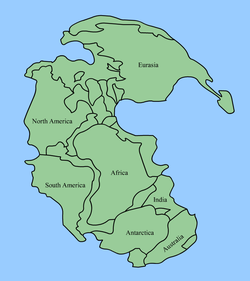
Translation Agency | Email US | Translation Resources | Translation Jobs | Translation Agencies
World Languages | Translation Tips | Translation Services
Translations of
Encyclopedia by Czech and Slovak to English translator

Translation Agency |
Email US |
Translation
Resources | Translation Jobs | Translation Agencies
World Languages | Translation Tips | Translation Services
When we look at the map of the world, we are immediately struck by the idea of how well Africa and South America, for example, would fit together. Southern Australia would match well with Antarctica. An analysis of
rocks determined, that certain types of minerals of the same type and the same age were found in Brazil and in West Africa. These rocks were at least 2 million years old.The same chronology of
ice ages, sedimentation, formation of coal, and other events also show that at one time these continents were joined. For example, one reptile living 250 million years ago (Permian), was found only in southern Africa and southern Brazil.Rocks that could have formed only under certain
climatic conditions are found in regions, where these conditions never existed. Examples are the coal deposits in Antarctica and evidence indicating that at one time masses of ice covered southern Africa.On the basis of all this evidence, we must conclude that our continents are not rigid and motionless, but that in the course of history their shape and form had changed. While searching for evidence, Alfred Wegener (1880-1930) introduced in his book dealing with the origin of the continents and oceans, which was published in 1915, a decisive argument for the continental shift theory.
 |
Over the earth's age of 4.6 billion years, it is
natural that its originally molten lava and volcanic surface would have
cooled over time, to create a crusty surface, some of which would poke out
above the surface of the water. The first known supercontinent to be formed
is Rodinia <look up root of word...> , about 1.1 billion years ago.
Pangaea (left) formed about 250 million years ago. But as the earth's crust is constantly moving due to the convection currents below it, Pangaea also broke up into smaller continents, to what we see today. A round 35 million years ago Antarctica separated enough from India that it allowed the ocean currents to circle around it. This new circulation allowed the cold to stay in the south pole, forming a permanent ice cap (also in the north pole, as a result < ).With the preasant global warming < taking place and the melting of the artic ice, it would be interesting to see the effect if the Gulf Stream would continue north into the arctic and possibly change the flow of the earth's ocean currents. |
In keeping with his theory, we assume the existence of a "supercontinent," which enveloped the entire surface of the earth. It is called "Pangea" (in Greek: the entire earth). Long time ago it separated into the individual continents (continental drift). About 250 million years ago, Pangea began to separate into two large continents: Laurasia in the north and Gondwana in the south.
| Some 180 million years ago, Gondwana split into three parts:
Australia-Antarctica, South America-Africa, and India. The opening of the
southern Atlantic approximately 130 million years ago caused South America to
separate from Africa. India drifted towards Asia, with which it collided about
45 million years ago. Australia and Antarctica also separated at that time.
Roughly 10 million years ago, Laurasia broke up, forming North America and Asia
including Europe. As we said before, the argument in pro of Wegener's theory was the "similarity" of the continents as well as the similarity and age of the rocks and geological structures, and the findings of the same fossils on different coasts of the Atlantic. The only thing that was missing was a convincing explanation of why the continent of Pangea broke up. |
|
Only in the last few decades Wegener's hypotheses could be decisively confirmed and further developed. With the discovery of the
lithospheric plates, on which the continents drift, and also on the basis of the discovery of the regeneration of the ocean crust through the seafloor spreading, the continental drift theory became the plate tectonics theory of today.Translating Spanish Hungarian Translations Hungarian Spanish Translating Norwegian Italian Translations Italian Norwegian Translating Czech
Translation Agency |
Email US |
Translation
Resources | Translation Jobs
Translation Agencies | World Languages | Translation Tips | Translation Services

Copyright © KENAX, by Karel Kosman - All Rights Reserved Worldwide.